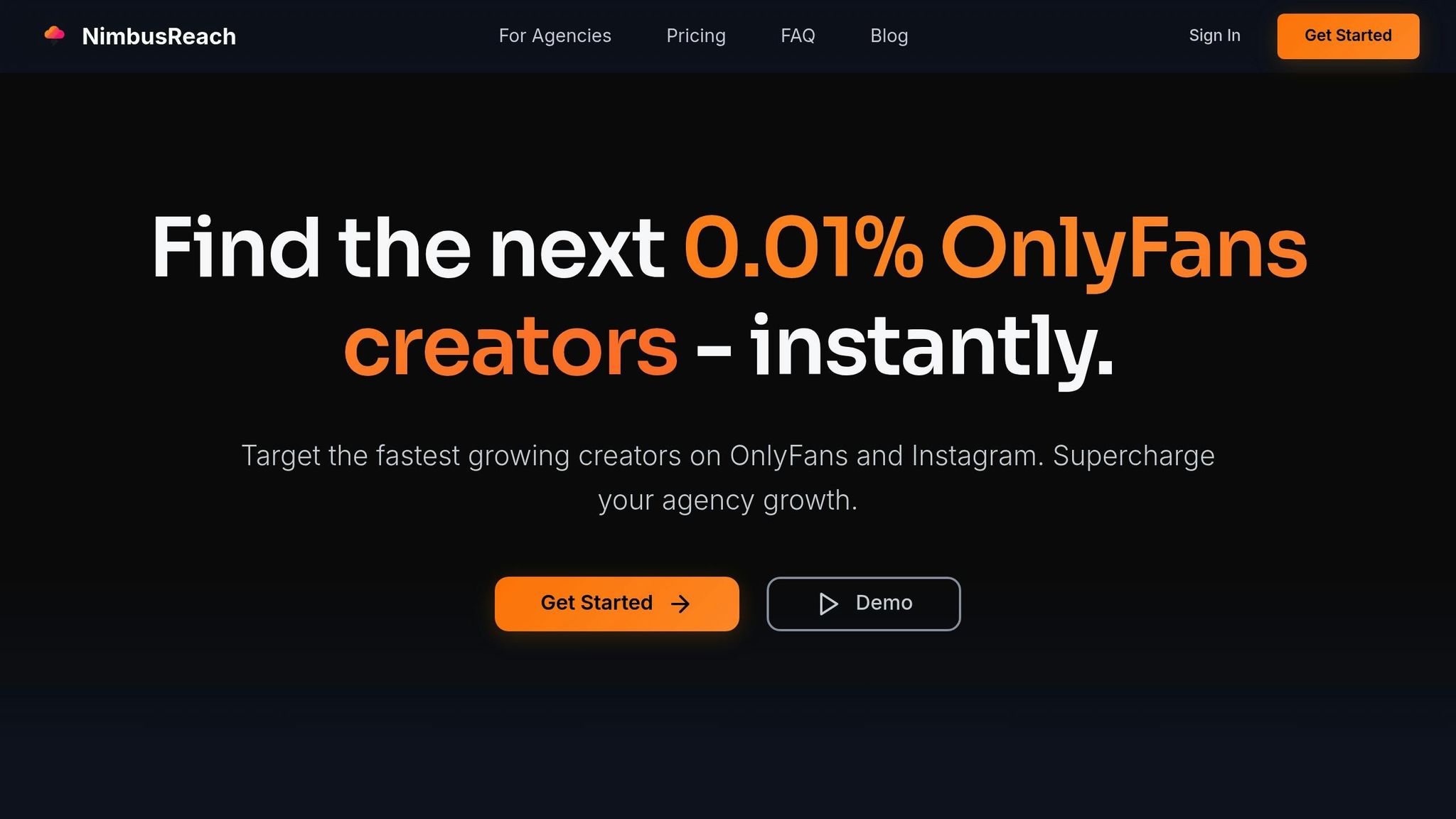Running an OnlyFans agency can be overwhelming with tasks like managing creators, engaging fans, planning content, and tracking finances. Automation tools can simplify these processes, saving time and reducing errors. Here’s a quick breakdown of how automation can transform your agency:
- Content Management: Use scheduling tools to plan and organize posts for multiple creators, ensuring consistent engagement without manual effort.
- Communication: Automate fan interactions with chatbots and messaging tools, while keeping high-value conversations personal.
- Analytics: Track performance metrics, audience behavior, and revenue trends to make data-driven decisions.
- Financial Management: Simplify payments, invoicing, and tax compliance with financial automation software.
Start small by automating repetitive tasks like scheduling or basic fan replies. Gradually expand to more advanced tools like AI-driven analytics or payment processing. Balance automation with personal interactions to maintain strong fan relationships, and prioritize data security to avoid compliance issues. By integrating the right tools, you can focus on growing your agency instead of getting buried in operational tasks.
11 MUST have tools for OnlyFans Agencies & OnlyFans Managers
Core Tools for OnlyFans Agency Automation
Using the right tools can simplify your agency’s operations by automating repetitive tasks and improving overall efficiency. Tools designed for content management, communication, analytics, and financial operations let you focus on what matters most – planning engaging posts, connecting with fans, tracking performance, and managing payments seamlessly. These solutions address key challenges, offering practical ways to streamline scheduling, fan interactions, reporting, and financial tasks.
Content Management and Scheduling Tools
Content scheduling platforms are a game-changer for agencies managing multiple creators. These tools let you plan and organize posts well in advance, ensuring a steady flow of content that keeps fans engaged.
Top platforms support batch uploads, allow scheduling across different time zones, and provide engagement metrics to track performance. Many include drag-and-drop visual calendars, making it easy to adjust schedules on the fly. For agencies juggling multiple creators, bulk scheduling features and collaborative tools with built-in approval workflows ensure smooth operations and consistent quality.
Automated Communication Tools
Fan engagement is critical, but replying to hundreds of messages daily can quickly become overwhelming. Automated communication tools streamline this process while maintaining a personal touch.
Chatbots and messaging automation handle routine fan interactions, send subscription reminders, and share promotional messages through pre-set flows. They filter simple queries, forwarding more complex ones to your team for a human response.
Email automation platforms extend engagement beyond OnlyFans, delivering welcome messages, birthday greetings, and re-engagement campaigns to keep fans connected during content lulls. SMS marketing tools are another effective option, offering direct communication with premium fans. These tools allow you to share exclusive updates, previews, and special offers with high-value subscribers.
Analytics and Reporting Software
To refine your strategies and maximize results, data is your best friend. Analytics tools provide the insights you need to evaluate what’s working and what needs improvement.
Comprehensive analytics platforms track fan behavior, traffic sources, and audience demographics, helping you fine-tune content strategies. They also reveal which marketing channels bring in the most valuable fans and identify the best times to post.
Revenue tracking tools offer real-time data on earnings, subscription trends, and fan spending habits. Many agencies create custom dashboards to consolidate data from various sources, giving them a full picture of performance at a glance.
Payment Processing and Financial Automation
Managing payments for multiple creators requires accuracy and compliance with US tax laws. Financial automation tools simplify this by ensuring timely, error-free transactions.
Integrated financial platforms handle invoicing, automated payouts, and tax compliance with ease, thanks to seamless integrations with banks and payment processors. They categorize transactions automatically and generate detailed financial reports, keeping everything organized for tax purposes.
Some tools also offer additional features like time tracking, project management, and invoicing tailored for service-based businesses. Tax compliance automation calculates sales tax obligations across states and simplifies filing, reducing the risk of errors.
The secret to successful automation lies in choosing tools that fit seamlessly into your existing workflows. Start with one category, and as your agency grows, gradually expand your toolkit. This step-by-step approach ensures that each tool adds real value and enhances your overall efficiency.
How NimbusReach Drives Data-Driven Creator Discovery and Outreach

Finding the right creators plays a key role in agency growth. With most top earnings concentrated among a small group of highly successful creators, NimbusReach simplifies the process of identifying and connecting with potential partners using data-backed insights. Its tools are designed to help agencies find creators who truly deliver results.
Advanced Search and Filtering
NimbusReach’s advanced search tools make it easier to pinpoint creators with high earning potential. The platform’s filters go far beyond basic demographics, allowing agencies to search based on factors like niche, estimated earnings, and engagement metrics.
This approach moves the focus away from simple follower counts, helping agencies zero in on creators who not only attract attention but also drive revenue and foster meaningful audience interactions.
Fan Devotion Score: A Unique Metric
One standout feature is the Fan Devotion Score, a proprietary metric that evaluates creator quality based on signals gathered from across the web. This score highlights creators with loyal, paying fans rather than those with inflated follower numbers but low engagement.
By analyzing a wide range of data, the Fan Devotion Score uncovers creators with genuinely engaged audiences. This insight allows agencies to focus their efforts on creators who are most likely to generate significant returns, cutting down on guesswork and making outreach more efficient.
Real-Time Growth Alerts
Timing matters in creator outreach, and NimbusReach’s real-time growth alerts give agencies an edge. These alerts notify users when a creator experiences a performance spike or rapid growth, ensuring agencies can act quickly.
This feature helps agencies approach creators at the right moment – when they’re gaining momentum and may be more open to partnerships. These timely updates also assist in managing relationships and optimizing outreach strategies.
Bulk Export and Outreach Tools
Managing outreach at scale can be challenging, but NimbusReach’s bulk export tools simplify the process. Agencies can quickly pull creator contact details along with key performance data, making it easier to launch effective communication campaigns.
The platform’s bulk export feature integrates seamlessly with email marketing and CRM systems, eliminating the need for manual data collection. Agencies can segment creators based on performance metrics and craft tailored messages for each group, improving response rates while saving valuable time.
Together, these tools create a streamlined system for discovering and building relationships with creators, helping agencies move seamlessly from identification to meaningful engagement.
sbb-itb-bd3d2dc
Best Practices for Agency Automation Implementation
Rolling out automation successfully requires a thoughtful approach that ensures efficiency without compromising quality. Agencies that dive in without preparation often end up with fragmented systems and frustrated teams. The secret? Taking deliberate, well-planned steps that build on one another.
Conducting a Workflow Audit
Before introducing any automation tools, it’s essential to get a clear picture of how your agency operates today. A workflow audit helps pinpoint where time is being wasted and which tasks are slowing you down.
Start by mapping out your current processes – everything from creator outreach to payment processing. Break it down step by step: How long does each task take? Who’s responsible for what? As you do this, look for repetitive tasks that eat up time, like replying to fan messages, scheduling posts, or compiling performance reports.
This audit should also uncover pain points – those moments where manual processes tend to fail. For instance, maybe creators miss posting deadlines, or responses to high-value fans are delayed. These issues often crop up during handoffs between team members or when juggling multiple creators at once.
Take content scheduling as an example. While the process might look similar across creators, the timing and messaging often vary. This makes it a great candidate for automation – it’s repetitive enough to streamline but still critical to get right.
By identifying these inefficiencies, you’ll have a clear roadmap for integrating tools that truly make a difference.
Connecting Your Tools
The real magic of automation happens when your tools work together seamlessly. If your systems operate in isolation, you risk creating data silos and doubling your efforts – exactly what you’re trying to avoid.
Start by integrating your core systems: CRM platforms, content management tools, communication channels, and analytics software. When these systems share data automatically, your team gets a complete picture without needing to jump between platforms or manually update records.
For example, imagine you’re using NimbusReach to identify promising creators. With the right setup, that data could flow directly into your CRM, trigger personalized outreach campaigns, and update your prospect tracking dashboard – all without lifting a finger. This eliminates manual data entry and ensures you don’t miss opportunities.
API connections are often the most reliable way to link tools. Many platforms even offer built-in integrations with popular software, making the setup process easier. If you’re dealing with more complex needs, integration platforms can bridge the gap without requiring advanced technical skills.
Before going all-in, test these integrations thoroughly. Set up monitoring systems to catch errors, like failed data transfers or glitches in automated processes. And always have a backup plan in place to keep things running smoothly if something goes wrong.
Once your tools are connected, the next step is ensuring your team knows how to use them effectively.
Training Teams on Automation Tools
Even the most sophisticated automation tools won’t deliver results if your team doesn’t know how to use them. Proper training is key to ensuring adoption and making automation a natural part of daily workflows.
Start training early, even before the tools are fully implemented. Focus on key team members who can act as internal champions – they’ll help train others and spot potential issues before agency-wide rollout.
Create clear, easy-to-follow documentation that explains not just how the tools work, but also why they matter. Include step-by-step guides for common scenarios, like managing creator profiles or handling fan interactions. This documentation will be a lifesaver for onboarding new hires or troubleshooting later on.
Hands-on practice is essential. Use real-life examples from your agency – creator campaigns, fan messages, or content schedules – to help team members see how automation improves their specific tasks.
It’s also important to address any concerns about automation replacing jobs. Be upfront: automation isn’t about cutting roles; it’s about freeing up time for higher-value work like strategy, relationship building, and creative problem-solving. When your team sees how automation enhances their work rather than replaces them, adoption becomes much easier.
Finally, schedule regular check-ins during the first few weeks post-implementation. These sessions give your team a chance to ask questions, share challenges, and suggest tweaks. Often, early feedback leads to small adjustments that make the system even more effective for your agency’s unique needs.
Common Automation Mistakes to Avoid
Agencies often face challenges when integrating automation into their workflows, risking creator relationships, unnecessary expenses, and even compliance issues. Building on the automation tools discussed earlier, it’s critical to sidestep common pitfalls to make the most of these tools. Let’s explore some of the most frequent mistakes agencies make and how to avoid them.
Balancing Automation and Personal Touch
One of the biggest missteps agencies make is relying too heavily on automation for fan interactions. While automating responses can save time, fans can quickly sense when messages lack a personal touch. This disconnect can alienate fans and, ultimately, reduce creator revenue.
Fans join OnlyFans to connect with creators on a personal level. If every interaction feels like it’s coming from a bot, that connection starts to crumble. The trick is figuring out what to automate and what to handle personally.
For example, automation works well for routine tasks like sending welcome messages or confirming payments. But for high-value moments – like when a fan spends $200 on custom content or shares a personal milestone – a genuine, personalized response is essential.
Think of automation as a starting point rather than the final step. You can use an automated system to draft responses based on fan messages, but have a team member review and customize them before sending. This approach balances efficiency with authenticity, ensuring fans feel valued.
The ultimate goal? Free up your team’s time so they can focus on meaningful, personal interactions with fans who matter most.
Data Privacy and Compliance Requirements
While maintaining a personal touch is vital, it’s equally important to ensure your automation processes comply with privacy laws and platform rules. Many agencies rush into automation without fully considering data protection laws or OnlyFans policies, which can lead to legal troubles or account suspensions.
To avoid these risks, make sure your automation tools prioritize fan data security, consent management, and compliance with relevant regulations. For instance, using bots to mass-message fans or scrape user data violates OnlyFans’ terms of service and can result in immediate account termination.
Before adopting any automation tool, verify that it offers essential features like data encryption, user consent management, and audit trails. These aren’t optional – they’re critical for staying compliant and protecting your account.
Additionally, ensure that fan data is stored securely and only accessible to team members who need it. Automated systems should include role-based permissions, limiting access to sensitive information. Regular security audits can help you catch vulnerabilities before they become serious problems.
If you’re unsure about compliance, consult a lawyer who specializes in privacy laws and adult content regulations. While legal advice might seem costly upfront, it’s far cheaper than dealing with penalties or account bans later.
Avoiding Tool Overload
Another common mistake is trying to automate everything at once using too many tools. This often results in an overcomplicated, expensive system that’s harder to manage than the manual processes it was meant to replace.
Every new tool adds complexity – more logins, more training, more integration headaches, and higher subscription costs. Instead of adopting dozens of specialized platforms, focus on automating your biggest pain points first with a streamlined set of tools.
For example, if content scheduling is consuming hours of your team’s time, prioritize automating that before diving into advanced analytics. If fan communication is overwhelming, address that before worrying about financial reporting.
When evaluating tools, don’t just consider the monthly subscription fee. Factor in setup time, training, and ongoing maintenance costs. A tool that seems affordable at $50 per month might end up being far more expensive if it requires constant tweaking or takes weeks to implement.
Whenever possible, choose platforms that handle multiple functions. While these solutions might have a higher upfront cost, they reduce complexity by consolidating features into one system. This means fewer integrations to manage and a single support team to contact if issues arise.
Before committing to a new tool, ask yourself: Does this solve a real problem, or does it just seem appealing? Agencies often get distracted by flashy features that don’t address their actual challenges.
Finally, set a budget for tools and stick to it. It’s easy to justify adding “just one more” subscription, but these costs add up quickly. Review your tool stack quarterly and eliminate anything that isn’t providing clear value. A lean, efficient system is always better than an overloaded one.
Key Takeaways for OnlyFans Agency Automation
Streamlining your OnlyFans agency is all about blending the right tools with smart strategies to cut out repetitive work while keeping the human connection alive.
To manage larger creator rosters without compromising quality, focus on these four key areas: content management, communication workflows, analytics, and payment processing. When these systems are integrated effectively, they lay the groundwork for smoother operations.
One standout advantage is using data to discover top-performing creators. Tools like NimbusReach, with its advanced filters and Fan Devotion Score, help identify creators who have loyal, paying fans. This targeted approach boosts efficiency and drives agency growth since most earnings often come from a handful of highly successful creators rather than a broad group of average performers.
Conducting a workflow audit can help you pinpoint the tasks that eat up the most time. Start by automating those major pain points first. The key is to begin small and expand gradually – once your team gets comfortable, you can scale automation to other areas for even greater efficiency.
Striking the right balance between automation and personal interaction is crucial. Use automation to handle routine tasks, but reserve meaningful moments for genuine engagement. This mix ensures you maintain the authentic connections that are vital to success on OnlyFans while freeing up time for growth-focused activities.
Don’t overlook the importance of data security and compliance. Any tool you use must prioritize these factors, as the risks of non-compliance can outweigh the benefits of automation.
Lastly, avoid overwhelming your team with too many tools. Stick to a few integrated, multi-functional platforms instead of juggling numerous specialized ones. This approach improves performance and keeps processes manageable.
FAQs
What are the first steps to automate an OnlyFans agency, and how do I decide which tasks to prioritize?
To begin automating your OnlyFans agency, start by pinpointing the tasks that eat up the most time. Common culprits include content scheduling, fan messaging, and payment processing. These repetitive activities are prime candidates for automation and can have a big impact on your workflow.
Zero in on tasks that boost both efficiency and fan engagement. For instance, you can set up automated messages to welcome new subscribers, share updates about new content, or promote exclusive offers. These small tweaks not only save time but also keep fans engaged and satisfied. By focusing on these areas, you’ll be able to manage creators more efficiently and scale your agency without being bogged down by manual work.
How can I make sure my automation tools for managing an OnlyFans agency follow data privacy laws and OnlyFans platform rules?
To make sure your automation tools align with data privacy laws and OnlyFans’ platform rules, start by thoroughly reviewing the platform’s Terms of Service. Pay close attention to key areas, including content ownership, intellectual property rights, and age verification requirements. Understanding these details helps you steer clear of potential violations.
On top of that, comply with privacy regulations like the GDPR and CCPA by taking critical steps such as securing data storage, obtaining explicit user consent, and maintaining clear, easy-to-understand privacy policies. Opt for tools that are built with compliance in mind, and schedule regular legal audits to minimize risks. These practices not only protect your agency but also ensure smoother day-to-day operations.
How can I use automation while still keeping interactions with fans personal and genuine?
To maintain the right mix of automation and personal interaction, begin by dividing your audience into segments based on their preferences and how they engage. This way, you can send tailored automated messages that come across as thoughtful and relevant.
Use automation for routine tasks like answering FAQs or sending payment reminders. However, save genuine, personal communication for key moments – like responding to unique fan questions or celebrating milestones. This method keeps fans feeling valued while allowing you to efficiently manage a growing audience.





